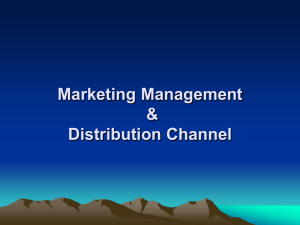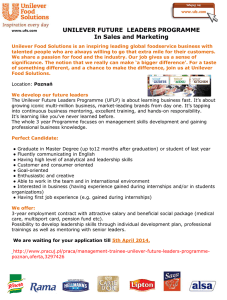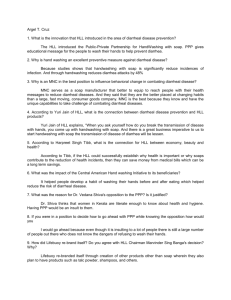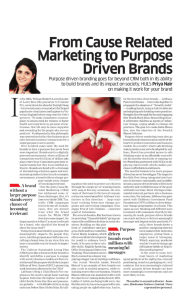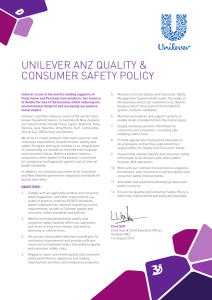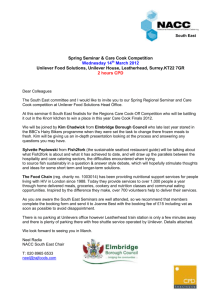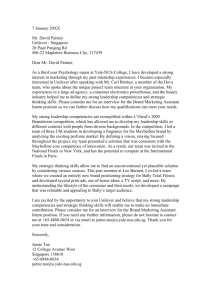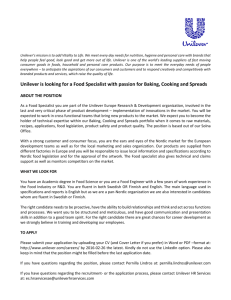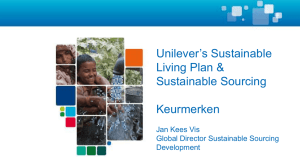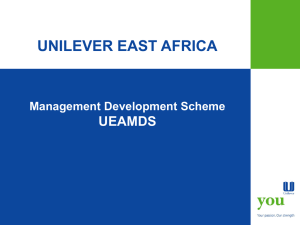Lifebuoy (soap)
advertisement
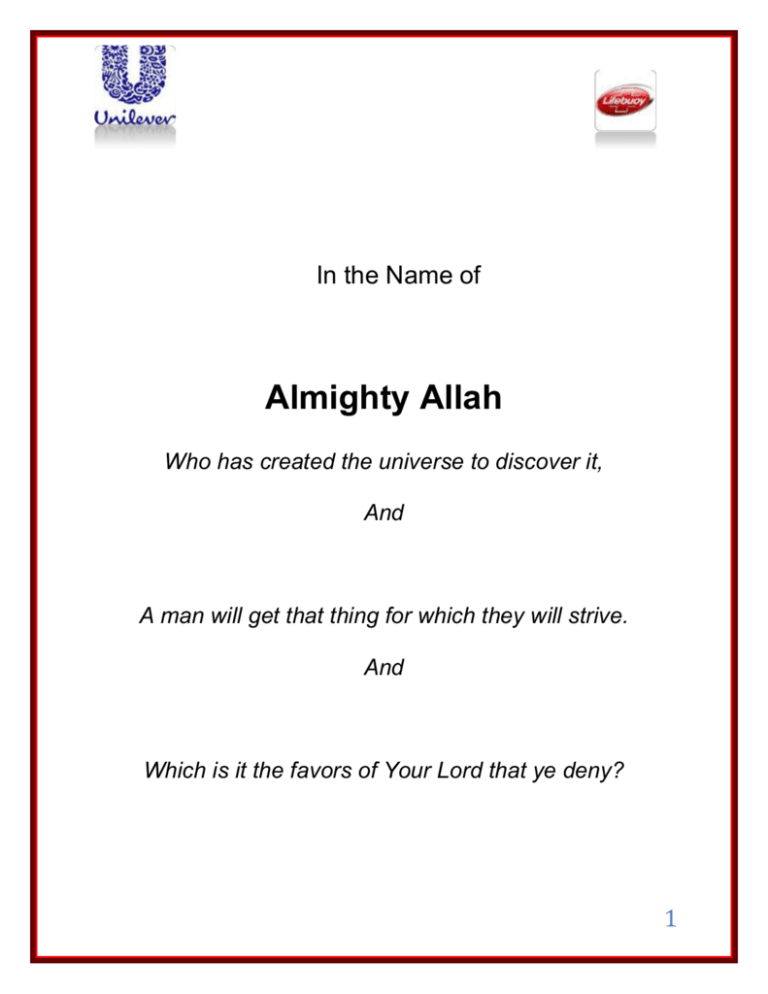
In the Name of Almighty Allah Who has created the universe to discover it, And A man will get that thing for which they will strive. And Which is it the favors of Your Lord that ye deny? 1 COMSATS INSITITUTE OF INFORMATION TECHNOLOGY GROUP-4 REPORT NO 1 SUBMITTED BY SUBMITTED TO 2 MISSION STATEMENT Unilever's mission is to add vitality to life. We meet everyday needs for nutrition with brands that help people feel good, look good and get more out of life. COMPANY’S INTRODUCTION HISTORY Unilever was created in 1930 by the amalgamation of the operations of British soap maker Lever Brothers and Dutch margarine producer Margarine Unie, a merger as palm oil was a major raw material for both margarines and soaps and could be imported more efficiently in larger quantities. In the late 19th century the businesses that would later become Unilever were among the most philanthropic of their time. They set up projects to improve the lot of their workers and created products with a positive social impact, making hygiene and personal care commonplace and improving nutrition through adding vitamins to foods that were already daily staples. 3 Today, Unilever still believes that success means acting with 'the highest standards of corporate behavior towards our employees, consumers and the societies and world in which we live'. Over the years we've launched or participated in an ever-growing range of initiatives to source sustainable supplies of raw materials, protect environments, support local communities and much more. Through this timeline you'll see how our brand portfolio has evolved. At the beginning of the 21st century, our Path to Growth strategy focused us on global high-potential brands and our Vitality mission is taking us into a new phase of development. More than ever, our brands are helping people 'feel good, look good and get more out of life' – a sentiment close to Lord Leverhulme's heart over a hundred years ago. In 19th century Although Unilever wasn't formed until 1930, the companies that joined forces to create the business we know today were already well established before the start of the 20th century. 1900s Unilever's founding companies produced products made of oils and fats, principally soap and margarine. At the beginning of the 20th century their expansion nearly outstrips the supply of raw materials. 1910s Tough economic conditions and the First World War make trading difficult for everyone, so many businesses form trade associations to protect their shared interests. 4 1920s With businesses expanding fast, companies set up negotiations intending to stop others producing the same types of products. But instead they agree to merge - and so Unilever is created. 1930s Unilever's first decade is no easy ride: it starts with the Great Depression and ends with the Second World War. But while the business rationalizes operations, it also continues to diversify. 1940s Unilever's operations around the world begin to fragment, but the business continues to expand further into the foods market and increase investment in research and development. 1950s Business booms as new technology and the European Economic Community lead to rising standards of living in the West, while new markets open up in emerging economies around the globe. 1960s As the world economy expands so does Unilever and it sets about developing new products, entering new markets and running a highly ambitious acquisition programmed. 1970s Hard economic conditions and high inflation make the '70s a tough time for everyone, but things are particularly difficult in the Fast Moving Consumer Goods (FMCG) sector as the big retailers start to flex their muscles. 5 1980s Unilever is now one of the world's biggest companies, but takes the decision to focus its portfolio, and rationalize its businesses to focus on core products and brands. 1990s The business expands into Central and Eastern Europe and further sharpens its focus on fewer product categories, leading to the sale or withdrawal of two-thirds of its brands. The 21st century The decade starts with the launch of Path to Growth, a five-year strategic plan, and in 2004 further sharpens its focus on the needs of 21st centuryconsumers with its Vitality mission PRODUCT PORTFOLIO UNILEVER’S BRANDS Home care brands Personal care brands Nutrition Health, hygiene & beauty Unilever Food solutions FOOD BRANDS Unilever is one of the world's leading food companies. Our passion for understanding what 6 people want and need from their food - and what they love about it - makes our brands a popular choice. Blue Band Blue Band is essential for a family’s healthy growth and development and to enjoy a lifestyle full of vitality. Brooke Bond A1 Brook Bond A1 is the strong cup of tea that gives the strength to face challenges and stand up for what you believe in. Flora Flora margarine spread is an important source of ‘good’ fats which help keep your heart healthy. Lipton Lipton is Tea – Tea is Lipton. Pearl Dust Lipton Pearl Dust is the Sindhi soul that imbues intimacy and warmth in a couple’s relationship 7 Supreme Brooke Bond Supreme is part of life for the Pakistani consumer, bringing families closer together with its rich taste and traditions Unilever Foodsolutions Your partners for success. Wall's The Wall's brand stands for a good time. HOME CARE BRANDS In many parts of the world we lead the home care market, with brands such as Omo, Surf, Comfort and Cif. It's more than just hygiene – with homes and clothes that are clean and cared for, we help you get more out of life. Comfort Comfort was launched in Pakistan in July 2007 and is available in 3 variants: Comfort Floral Pink, Comfort Classic Blue and Comfort Pure White. 8 Rin Consumer insight shows that one of the leading drivers that indicate a good wash is the level of whiteness and brightness that clothes have after the use of a detergent powder. Rin is formulated to offer whiteness and bring back life in your everyday clothes. Surf excel Remember when you were a child? How you were free to explore, returning home covered in dirt and other stains that you wore like the badges of an intrepid discoverer? PERSONAL CARE BRANDS Our personal care brands, including Dove, Lifebuoy, Lux, Pond's, Rexona and Sunsilk, are recognized and respected around the world. They help consumers to look good and feel good – and in turn get more out of life. Clear Clear spells confidence for the young Pakistanis of today. 9 Close Up Our mouths are our gateway to life. We use them to eat, drink, talk, laugh, smile and what not! Fair & Lovely Asia’s leading fairness brand. Lifebuoy shampoo Providing healthy hair to all Pakistani consumers. Lifebuoy soap Lifebuoy's goal is to provide affordable and accessible hygiene and health solutions. Lux 10 Lux brings out the star in you! Pond's Making a real difference to women's skin and the way they live their lives. Rexona With Rexona you know your deodorant won’t let you down. Sunsilk Sunsilk provides real solutions to women's everyday hair needs everywhere. PRODUCT’S INFORMATION Lifebuoy (soap) Lifebuoy is a brand of soap containing phenol marketed originally by Lever Brothers in England beginning in 1895. 11 History: Popular for over 100 years, the light red soap is still available in the United States, in specialty shops that import it through Jupiter Imports (UK) in England. Though Lifebuoy has ceased to be produced in the U.S. and the UK, it is still being mass produced by Unilever in Cyprus (for the UK, EU and USA). In India, it is the main value brand there as well as in some other South Asian and South East Asian countries like Malaysia, Singapore, India, Pakistan, Sri Lanka, Bangladesh and Indonesia. Objectives and Goals: http://en.wikipedia.org/wiki/File:LifeboySoap.jpg Lifebuoy's goal is to provide affordable and accessible hygiene and health solutions that enable people to lead a life without fear of hygiene anxieties and health consequences. Improving health & hygiene for over 100 years: Lifebuoy is one of Unilever's oldest brands, a brand that was truly 'global' before the term 'global brand' was invented. Lifebuoy Royal Disinfectant Soap was launched in 1894 as an affordable new product in the UK, to support people in their quest for better personal hygiene. Soon after launch, Lifebuoy soap travelled across the world, reaching countries such as India, where even today it is still the market leading brand. Lifebuoy saves lives: Consistent in Lifebuoy's 110+ year history has been its championing of health through hygiene. The brand's core promise of protection and a commitment to support life through unbeatable protection is at the heart of the brand name itself – Lifebuoy, the guarantee of protection when you are threatened. For example, a 1930's campaign in the US was titled 'Clean hands help guard health', encouraging the use of Lifebuoy soap to kill the germs on hands that can cause health issues. A similar campaign 12 continues today, with Lifebuoy hygiene education programmes ongoing in countries including India, Bangladesh, Pakistan, Sri Lanka, Indonesia and Vietnam. Innovation: Since 2000, major changes have been made to the classic Lifebuoy soap bar to ensure that it provides improved hygiene protection and a more enjoyable healthy washing experience for its billions of consumers. Lifebuoy's classic hard red brick shape has been replaced with a new signature Lifebuoy shape. The new shape makes the bar easier to grip and use The Lifebuoy team have developed a new formulation providing even better germ protection which creates a rich lather on the skin Lifebuoy's characteristic medicated, carbolic smell has been replaced with a more enjoyable and contemporary 'health' fragrance Lifebuoy has become more than just a red bar of soap – today the brand provides hygiene and health solutions for families, including a range of bar soaps, hand wash liquids and liquid shower gels. The most recent Lifebuoy innovation addresses the number one skin hygiene and health concern for teens and tweens: oily and acne prone skin. Lifebuoy Clear Skin is a bar soap formulated using radical new technology that is clinically proven to reduce even severe acne, by 70% in 6 weeks. Regular use, twice a day is proven to prevent and reduce the recurrence of acne Key Facts: Today Lifebuoy is sold in Asia and parts of Africa. It is market leader in every Asian market where it is sold Lifebuoy soap has been proven in laboratories to provide 100% more effective germ protection than ordinary soaps To date, 70 million people in rural India alone have experienced Lifebuoy's pioneering Health Education programme – the single largest private hygiene education programme in the world 13 In 2005, Lifebuoy was awarded a 'Citizen Brand' accolade in Indonesia in recognition of the work the brand has undertaken in hand wash education Nearly half of the Lifebuoy brand's consumption is in rural Asia, where most of the population live on less than US$1 per day LIFEBUOY’S MARKETING STRATEGY Life buoy’s Market Segmentation and Targeting: The targeting market for lifebuoy is all households who can afford buying soap and who want to fulfill everyday need that provides them and their family with a 100 anti bacterial solution and complete protection from all germs bacteria and cleanliness from dirt 14 Lifebuoy belief that children are the potential agent for change and imparting education on the importance of hand washing with soap will enable them to adopt early habit in life Lifebuoy’s Repositioning Strategy: Lifebuoy soap is a very old brand of bath soap in Pakistan, Life Buoy is an anti bacterial soap and in the beginning it positioned itself on its antibacterial qualities, life buoy gained a number of customers with this positioning, but then there comes the competition first the Safeguard and then Dettol soap, these two soaps are from very strong companies especially safeguard is on P&G which is one of the largest consumer products companies in the world, Safeguard offers better quality soap with good fragrance, apart from these features, Safeguard adopted fear strategy in its advertisements and it helped it in gaining more customers and soon Safeguard became the first choice in antibacterial soaps. Safeguards effective campaigns including character of Commander Safeguard outturned every competition, only Dettol soap was competing head to head with safeguard. All this put Lifebuoy out of lime light and to survive in market, Lifebuoy positioned itself on price it became low price antibacterial soap. This strategy may have boosted short term sales of Lifebuoy but it lost its brand value and credibility in the minds of customers. Lifebuoy needed to reposition itself on quality rather than price. Repositioning Campaign: The repositioning campaign of Lifebuoy was started at 2008, but it became more prominent and became effective in 2009, Lifebuoy along with the advertisement has improved its quality and fragrance, most of the people had shifted from lifebuoy because it was low quality and it smelled terribly, as Lifebuoy has improved its quality all 15 it needed to run an effective advertisement campaign to get the customers attention. The advertisement team of Lifebuoy came up with excellent theme “Healthy Hoga Pakistan” and it is targeting parents which is their target market, Lifebuoy made very effective ad and it also used fear strategy (which is effective in case of antibacterial soap). This has enabled Lifebuoy to get more and more customers. Now a days, Lifebuoy is everywhere in Television, Radio, Newspapers and Billboards, Lifebuoy is running a huge campaign to promote itself which is very necessary in case of Project Report 2 repositioning the brand. With the help of marketing department and advertisement, Lifebuoy has successfully repositioned itself as a quality antibacterial soap with better fragrance and more durability. Many companies try to reposition themselves when they see market trend shifting but most fail to do so. In case of Lifebuoy it has been successful. The interesting thing about this campaign is that Lifebuoy is running the same campaign in Pakistan and in India as is done by Unilever, this suggest that Lifebuoy is considering India and Pakistan as the similar market segment. 16 SURVEY ANALYSIS REPORT This Survey Analysis Report is based on the Questionnaire assigned to get the responses of the individuals within Comsats Institute of Information Technology. We have tried to establish our questionnaire in a way that best fits the marketing related issues of our selected product i.e. Lifebuoy. In preparing this questionnaire we have focused on the current marketing issues faced by Lifebuoy and discuss some current strategies of the product as well to get the responses about its new developments. It was an interesting task on our part because no one amongst us had the knowhow about conducting surveys, preparing questionnaires and to get the honest views from others. For all that we divided 10 questionnaires to each individual. We gathered data from students and some of the faculty members as well. To create diversity in the sample group we visited almost every department of the university, from Department of Electrical Engineering to Department of Physics, from Architecture to Department of Computer Sciences and mainly Department of Management Sciences. We got a very good response from all sides and we are thankful to all those who cooperated with us and helped us in conducting that survey. We pay special thanks to the students of Management Sciences for their full cooperation and their valuable suggestions. In the following Survey Analysis Report we tried to explain the results of each question through respective table and graph and in the end a short interpretation of the result we received. In graphs, we have used pie chart as a standard for all which is not only depicting the percentage of each result but also shows the number of responses of each side. The complete analysis report is here under. 17 SURVEY ANALYSIS REPORT 1. Sample Index 52 Male 26 Female 28 INTERPRETATION: Out of the total sample of 52, 26 are male and 28 are females 2. Age limit Frequency Below 20 15 20-25 38 25-30 1 Above 30 0 Most of the correspondents are from young age group, 15 are under 20 years and 38 are in the age group of 20-25 years. Only a few of them represents the other age groups. 3. What kind of soap you generally like to use? Beauty soap 14 Skin softener 15 Anti bacterial 18 Any other 7 18 The sample data shows that people have varied perception in using different kinds of soaps. Here a mixed response is shown in case of beauty soap, skin softeners, antibacterial or any other soap, but still more people like to use antibacterial soaps. 4. How long you are using Lifebuoy? Since Lifebuoy is quiet an old product, most have the people have well used it. There are some correspondents who use it from their childhood; some have used it for a short period like for a month and some have just only one time. 5. Do you like its red color? Yes 20 No 34 Lifebuoy has its red brand color but sample shows us that most of the people now don’t like this color; only 37% people are in favor of this color. 6. Do you like its smell? Yes 18 No 36 Same is the case with its smell. 67% people don’t like its smell and there is a lot of need to improve it to be good in the customer’s mind. 19 7. Does it give you a fine and soft lather? Yes 32 No 22 Positive response is seen in its lather quality, 59% suggests its lather to be soft and fine 8. Do you find any healthy change in your skin after using Lifebuoy? Yes 20 No 34 Lifebuoy is not up to the mark in creating soft and mild effect on the skin after use, since only 37% of people think that it has good impact after use. 9. How it makes your skin after use? Dry 23 Soft 08 Smooth 20 Oily 03 Mix response is coming out of the after use impact, with 43% says that it makes your skin dry and 20% have the opinion that it makes your skin smooth while a minimum portion of the sample data says that it makes skin soft and oily. 20 10. How its price is making an impression in your mind? High price 2 Low price 44 Very low price 2 Any other 4 The results shows that most of the people consider it to be a low priced product and even very low price product by a small group of people. 11. Is it a quality product? Yes 26 No 28 Again, people have varied perception about its quality. With 48% think that it is a quality product while 52% think that it is not a quality product. 12. How you perceive its quality to be? High quality 11 Low quality 34 Very low quality 3 Any other 6 This question shows us that people are not satisfied with the quality of product since 63% people consider it to be a low quality product and only 20% are of the opinion that it is a quality product. 21 13. How you see its new signature shape with hard red brick shape? Very good 7 Good 38 Poor 3 Any other 6 The new innovative signature shape is considered to be good by 70% of the sample population, 6% are those who considered it to be a poor shaped product and 11% think that it is neither good nor poor. 14. Does this shape help you to grip it easily? Yes 37 No 17 The results suggest that the new signature shape is more helpful in griping the bar with 69% has agreed and 31% are disagreed to the above statement. 15. Does this shape help to create more lather? Yes 22 No 32 The result shows that the new signature shape is more lather creating than conventional red hard brick soap. Here 59% has selected Yes and 41% selected No. 22 16. Are you satisfied with the products packaging and branding? Yes 41 No 13 76% people are satisfied with the product packaging and branding while only 24% are dissatisfied. 17. Are you satisfied with the soap size? Yes 46 No 8 Very positive response is received in satisfaction of bar size where 85% are satisfied with bar size and only 15% are dissatisfied. 18. Is it true that Lifebuoy has addressed properly to the oily and acne prone skin problems? Yes 18 No 36 Being an antibacterial soap Lifebuoy has got 67% success in addressing properly to the oily and acne skin problems. 23 19. Have you experience Lifebuoy’s hand wash liquids and liquid shower gels? Yes 18 No 36 The two new products introduced by Lifebuoy, don’t get the desired results as only 33% of the population have experienced them. 20. Do you think Lifebuoy’s current marketing campaign “Healthy Hoga Pakistan” is creating an impact in customers mind? Yes 46 No 8 Healthy Hoga Pakistan reflects the new marketing strategy of Lifebuoy.85% of the population agree that it is creating the desired impression in the customers mind while only 8% are disagreed with the above statement. 21. Do you find Lifebuoy a success in providing basic health and hygiene product in every part of Pakistan? Yes 33 No 21 Lifebuoy has got 61% success in providing health and hygiene product in every part of Pakistan where 39% population think that Lifebuoy has failed in its mission i.e. providing a basic hygiene product to each individual of the country. 24 22. Do you think there is still some need to improve the product quality? Yes 49 No 5 The responses of the above question shows that more improvement is required to get a value in the customer’s mind as 91% of the sample population shows that Lifebuoy has to make some efforts in improving the products quality. 23. The brand is my preference? Yes 20 No 34 Lifebuoy has not succeeded in getting preference in the consumer’s mind as only 63% population don’t consider it as their preference. 24. The brand is comparable to others? Yes 33 No 21 Although it has not got the preference still 61% people consider it to be comparable to other brands. 25 Suggestions received: We are thankful to all those who made their kind suggestions and make it easy for us to analyze it properly. Out of the 50 responses the suggestions received deals with the following facts. 1. Improve the quality of the product 2. Improve brand packaging and labeling 3. More innovation is required in making bar design beautiful. 4. The brand image is not up to the mark and there should be some effort to improve the brand image. 5. Some people suggest that it has a bad smell and there is need to add a new fragrance. 6. Since it has passed a long time in the market, it has lost its significance, so go for the product development and try to recapture the market with a new marketing strategy. 7. A lot of people think that Lifebuoy has to initiate better marketing and advertising campaign. 8. Some people think that Lifebuoy has not developed its target market properly, some time advertise itself through children campaign and some time targeting health conscious families, so it is quite confusing. It is however necessary for Lifebuoy to target each segment with its respective 4P’s. 9. There is a lack of celebrity endorsement in Lifebuoy‘s campaign so initiate advertisements by endorsing celebrities to be the “opinion leader” in the market. 10. In the last, many of the correspondents think that Lifebuoy has now become a cultural part of the society and to adjust its marketing strategies according to the cultural norms of the society. 26 MARKET STRATEGIES Here in marketing strategies we will discuss the existing strategy of Lifebuoy along with some adjustments in the strategies to improve our selected product. The discussion of these market strategies are hereunder. MARKET SCOPE STRATEGY: Although Unilever itself is a part of a Multi market, but since we are talking about the product Lifebuoy we can say that it is using a multi market strategy as well because it has both soap and shampoo, not these two only but they have others antibacterial liquid baths as well opening a way for Lifebuoy to be a multiple product. EVALUATION: In evaluating this multimarket strategy, one comes to know that Unilever is well using its product of Lifebuoy in promoting its business. It has diversified that brand into different categories to capture every part of the market. This strategy is helping Unilever in a way that due to variety of products it not only saves the existence of a single product but also saving other products which are complement to it. 27 MARKET GEOGRAPHIC STRATEGY: Geography has long been used as a strategic variable in shaping market strategy. History provides many examples of how businesses started locally and gradually expanded nationally and internationally. Unilever is having an international market strategy for Lifebuoy being available in almost every continent of the world. It is a worldwide brand of Unilever available in India, China, Indonesia, Cyprus, UK, USA along with Pakistan. EVALUATION: Lifebuoy has more than a life of 100 years, providing Unilever a key support in all of its brand buckets. Unilever knows the significance of its brand therefore it has globalized this product by making it an international brand. It has made it available in Asia and Africa where it is used by those people who have a daily income of less than 1 $. So Lifebuoy is well in line with its goals and objectives providing hygiene and health solutions that enable people to lead a life without fear of hygiene anxieties and health consequences. MARKET ENTRY STRATEGY: Lifebuoy is one of the old products of Unilever which has more than 100 years of successful journey, we can simply say that Lifebuoy is the early entrants internationally and in Pakistan it is the first-in in its kind of soaps. By adopting the first-in strategy, Lifebuoy has captured the maximum share of the market. Over 60 years in Pakistan we guess there is not a single home that didn’t use it. Lifebuoy has taken the risk of the first-in 28 and consequently got one of the biggest markets in Asian countries by providing its quality and sustained priced product to both rural and urban areas of Pakistan. MARKET COMMITMENT STRATEGY: Being the first-in in the market Unilever has shown strong commitment with its brand of life time i.e. Lifebuoy and that commitment to its brand has really foster the growth of Unilever as well as its brand of Lifebuoy. But from the recent decade Unilever is no more showing the strong commitment to Lifebuoy because over the period of time many of the competitors came in the market with new innovative product, better market strategies and stronger commitment, e.g. Safeguard, Palmolive, and Dettol etc. In the present scenario, Unilever is just showing an average commitment to its brand of Lifebuoy which has really put its brand on the back foot. EVALUATION: In evaluating the market commitment strategy it is necessary for the Unilever to again show strong commitment to its product. Although Unilever has well realized the situation and make changes in its strategies which are making some changes in the consumers mind but we think there is more need required to retrieve its image of better quality at lower price in the customers mind. 29 PRODUCT STRATEGIES PRODUCT POSITIONING STRATEGY: “Placing a brand in that part of the market where it will have a favorable reception compare with other brands”. Unilever position Lifebuoy when come in red colors as a brand of low income group. They choose their segment and position their brand according to the needs and wants of the segments. This segment wants long life of the soap and the chemical formula of Lifebuoy enables it to have long life. PRODUCT REPOSITIONING STRATEGY: Due to competition, Unilever has to reposition its brand Lifebuoy because the needs and wants of people are changed. Unilever should revise its marketing mix to reposition Lifebuoy. Now they are targeting whole Pakistan by the advertisement “Healthy Hoga Pakistan”. They position their brand for the health conscious people. In repositioning they changed the shape, color and the attributes of the Lifebuoy because want this kind of changes and they do this through environmental scanning. PRODUCT OVERLAP STRATEGY: Unilever is also using Overlap strategy between Capri and Lifebuoy. The potential customers move from Capri to Lifebuoy and from Lifebuoy to Capri. In this way they are keeping the potential customers with themselves. 30 PRODUCT SCOPE STRATEGY: Single Brand: Unilever is using single brand strategy when Lifebuoy came in traditional red color and use by lower income group. Multiple Brands: In order to attain the whole market Unilever has introduced Lifebuoy shampoo to capture more growth and profits. PRODUCT DESIGN STRATEGY Deals with the standardization of the product. Unilever is using two of product development strategies. Standard product: Unilever is offering a standard product of Lifebuoy soap and shampoo by standardized packaged product. Customized product: In case of Lifebuoy shampoo different sizes are available, customers use according to its requirements from 200ml bottle to 5ml sachet pack since there is no one time consumption. 31 PRICING STRATEGIES Market penetration: Market penetration is the name given to a growth strategy where the business focuses on selling existing products into existing markets. Market penetration seeks to achieve four main objectives: Maintain or increase the market share of current products – this can be achieved by a combination of competitive pricing strategies, advertising, sales promotion and perhaps more resources dedicated to personal selling Secure dominance of growth markets Restructure a mature market by driving out competitors; this would require a much more aggressive promotional campaign, supported by a pricing strategy designed to make the market unattractive for competitors Increase usage by existing customers – for example by introducing loyalty schemes 32 Fast Moving Consumer Goods (FMCG) like lifebuoy shop has to be Some requirements for making an impression in the market for penetrating: 1) Strong distribution channel 2) Minimum profit margin 3) Simple marketing message 4) Lesser-priced packs to increase affordability 5) Packaging in smaller units and localized design that attracts consumers 6) Convenience of storage while use 7) Thorough knowledge of the village psyche In brief, the strategy revolves around what attracts consumers to a product. How they penetrate Lifebuoy use more or less all the marketing tools, such as Promotion Pricing Distribution Process 33 PROMOTIONAL STRATEGIES Successful promotion campaigns don't happen by chance. To realize goals, promotional products programs must be carefully planned, taking into consideration the audience, budget and, of course, the ultimate result to be gained. 1. Define a specific objective. 2. Determine a workable distribution plan to a targeted audience. 3. Create a central theme. 4. Develop a message to support the theme. 5. Select a promotional product that bears a natural relationship to your profession or communications theme. 6. Don't pick an item based solely on uniqueness, price or perceived value. Don't fall prey to the latest trends or fads. The most effective promotional products are used in a cohesive, well-planned campaign. Sales promotions are non-personal promotional efforts that are designed to have an immediate impact on sales. Media and non-media marketing communications are employed for a pre-determined limited time to increase consumer demand, stimulate market demand or improve product availability. Lifebuoy is promoting its product using these kinds of promotional techniques Consumer sales promotion techniques: The different consumer sales promotion techniques used by Lifebuoy are Price deal: A temporary reduction in the price, such as happy hour Cents-off deal: Offers a brand at a lower price. Price reduction may be a percentage marked on the package. Price-pack deal: The packaging offers a consumer a certain percentage more of the product for the same price (for example, 25 percent extra). 34 Coupons: coupons have become a standard mechanism for sales promotions. Free-standing insert (FSI): A coupon booklet is inserted into the local newspaper for delivery. Rebates: Consumers are offered money back if the receipt and barcode are mailed to the producer. Contests/sweepstakes/games: The consumer is automatically entered into the event by purchasing the product. DISTRIBUTION STRATEGIES Movement of goods and services from the source through the distribution channel, right up to the final consumer, or user and the movement of payment in the opposite direction, right up to the original producer or supplier. Chanel of Distribution: A distribution channel can be as short as being direct from the vendor to the consumer or may include several inter-connected (usually independent but mutually dependent)intermediaries such as wholesalers, distributors, agents, retailers. Each intermediary got the items at one pricing point and moves it to the next higher pricing point until it reaches the final buyer also called channel of distribution or marketing channel. The Importance of Distribution: Most producers use intermediaries to bring their products to market they try to develop a Distribution channel to do this. A distribution channel is a set of Interdependent organizations that help make a product available for use or consumption by the consumer or business user. Channel intermediaries are firms or individuals such as wholesalers, agents, brokers, or retailers who help move a product from the producer to the consumer or business user. 35 A company’s channel decisions directly affect every other marketing decision. Place decisions, for example, affect pricing. Marketers that distribute products through mass merchandisers such as Wal-Mart will have different pricing objectives and strategies than will those that sell to specialty stores. Distribution decisions can sometimes give a product a distinct position in the market. The choice of retailers and other intermediaries is strongly tied to the product itself. Manufacturers select mass merchandisers to sell mid-price-range products while they distribute top-of-the-line products through high-end department and specialty stores. The firm’s sales force and communications decisions depend on how much persuasion, training, motivation, and support its channel partners need. Whether a company develops or acquires certain new products may depend on how well those products fit the capabilities of its channel members. Some companies pay too little attention to their distribution channels. Others, such as FedEx, Dell Computer, and Charles Schwab have used imaginative distribution systems to gain a competitive advantage. Functions of Distribution Channels: Distribution channels perform a number of functions that make possible the flow of goods from the producer to the customer. These functions must be handled by someone in the channel. Though the type of organization that performs the different functions can vary from channel to channel, the functions themselves cannot be eliminated. Channels provide time, place, and ownership utility. They make products available when, where, and in the sizes and quantities that customers want. Distribution channels provide a number of logistics or physical distribution functions that increase the efficiency of the flow of goods from producer to customer. Distribution channels create efficiencies by reducing the number of transactions necessary for goods to flow from many different manufacturers to large numbers of customers. This occurs in two ways. The first is called breaking bulk. Wholesalers and retailers purchase large quantities of goods from manufacturers but sell only one or a few at a 36 time to many different customers. Second, channel intermediaries reduce the number of transactions by creating assortments providing a variety of products in one location—so that customers can conveniently buy many different items from one seller at one time. Channels are efficient. The transportation and storage of goods is another type of physical distribution function. Retailers and other channel members move the goods from the production site to other locations where they are held until they are wanted by customers. Channel intermediaries also perform a number of facilitating functions, functions that make the purchase process easier for customers and manufacturers. Intermediaries often provide customer services such as offering credit to buyers and accepting customer returns. Customer services are oftentimes more important in B2B markets in which customers purchase large quantities of higher priced products. Existing strategy: Unilever uses a lot of distributors and retailers to supply its products in each market where the final customer might reasonably look for it. While appointing a distributor for a particular area, management uses its own judgment to select such a person that has a potential to operate effectively. Unilever uses an intensive distribution strategy for lifebuoy soap while at the same brand but in shampoos category it introduces only extensive strategy. Unilever did not fight for the better shelf space for lifebuoy soap. Lifebuoy is targeting middle and low income consumers so shelf space is not important our main focus is on intensive distribution and ideal price with some innovation. 37 SUGGESTED DISTRIBUTION STRATEGY: We have suggested that Unilever for life buoy should introduce a new kind of distribution strategy that will be a strategic fit between its productions to consumptions. Unilever should identify its larger, medium and small consumption areas and design the channel accordingly. According to my sense and survey lifebuoy must go for intensive distribution with wholesaler and retailers in the areas where rate of consumption is usually very greater than that of the other areas where comparatively rate of consumption is not so attractive. Lifebuoy is available at every outlet and at every big, medium and even at very small stores(hatti).Now we want to save the cost of per Tikki soap in Urban areas by reducing intensive approach and turning to a new strategy that a more easily applicable and sensible. 38 We have discussed the following diagrammatic distribution method of Unilever for Lifebuoy in the both Rural and Urban Market as well. We have eliminated the existence of wholesaler from in the Urban market as of many reasons It is a lower consumption area for Lifebuoy Warehousing cost can be a big trouble for wholesalers as they did not purchase extra quantity from distributors and company and definitely it increases cost of contacting to wholesaler and managing relationship. While the selection of channel company considers customer buying patterns and the nature of the market. 39 Urban Areas Rural Areas A A Distributor Distributor A A Retailers Wholesaler Retailers Customer 40 IMPROVED ACTION PLAN FOR LIFEBUOY We have tried to fully analyze the existing strategies of Lifebuoy, what we find from this detail analysis are discussed as improved version of Lifebuoy where suggestions are given from our side and what adjustments can be made in the present strategies to improve the product performance and overall image of the product in the customer’s mind. In evaluating the position of the Pakistani market, Lifebuoy is lacking in its market Geography strategy as it is more common in rural areas of the country where more of the urban citizens keep it as a low level brand. The major challenge Unilever has to face is its commitment to its old brand of Lifebuoy. Unilever got a major setback when P&G introduced Safeguard through a heavy media campaign. Unilever has tried to compensate that through promotional program of “Healthy Hoga Pakistan” but still it needs a strong and continuous commitment to this product. Lifebuoy has well repositioned itself but still there is need to change the image that it is a low quality low price product. In penetrating the market through price, Lifebuoy has to compete with brands of P&G and Colgate-Palmolive which are a good name of quality, so accordingly Lifebuoy has to adjust its prices at that level where it creates dominance among the existing brands. In promoting the worth of the Lifebuoy, it has to modify its promotional campaigns base on traditional heroism and fantasy; one is to come up with new realistic approaches highlighting the need of an antibacterial soap in most hygienic environment. 41 While deciding about the selection of Channel Company should consider customer buying patterns and the nature of the market. A general distribution pattern with distributors and retailers are the agents in the urban areas to remove lag time in delivery of the product. Since in rural areas the places are diversified so to improve the distribution there is an inclusion of the whole seller to make the distribution extensive. These are some suggestions from our side identified through complete analysis and view of Lifebuoy. We hope that these suggestions can make a difference in the Lifebuoy by proper implementation and planning. 42 Bibliography Google.com Wikipedia.com Scribd.com Marketing teachers .com Marketingprofs.com Dostoc.com Slideshare.com Principle of marketing “Philip kotler”. Comsats Students Survey Outsiders Survey Group Meetings Seniors Special Contribution and Thanks TO Qaisar Sajjad Khan( Girdi,Jand,Attock,Pakistan) 43
